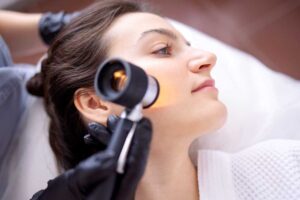Doxycycline is one of the most commonly prescribed antibiotics used to treat moderate to severe acne. It works by killing acne-causing bacteria, reducing inflammation, and helping to unclog pores. Most dermatologists prescribe it to patients dealing with severe inflammatory acne, cystic acne, or acne vulgaris when topical treatments like benzoyl peroxide or topical retinoids don’t show strong results. But here’s the burning question: Does acne come back after doxycycline? For many people, doxycycline helps clear the skin while they’re taking it. But what happens after you stop? Does the acne return? Keep reading, because we’ll cover how to make your results last longer and what aftercare steps matter most.
How Doxycycline Works to Treat Acne
Doxycycline treats acne by going deeper than surface-level products. It is an oral antibiotic that targets the root of the problem(bacterial infections, blocked pores, and skin inflammation). When your pores fill with dead skin cells, oil, and bacteria, it creates a perfect breeding ground for pimples. Doxycycline reduces the bacteria and calms inflammation, giving your skin a chance to heal.
Doxycycline is effective for treating severe acne and inflammatory acne, which don’t respond well to over-the-counter options. That’s why healthcare providers often turn to doxycycline when other topical acne treatments fall short.
What to Expect During the Doxycycline Treatment
If your healthcare professional has prescribed doxycycline for acne, they’ll usually recommend a course that lasts about a month to several months. You may begin seeing early results within two to four weeks. The beginning of the process might come with a purging stage. That’s when your skin pushes existing breakouts to the surface. This doesn’t mean doxycycline is making your acne worse, it’s just clearing the decks so your skin can start fresh.
It’s essential to keep up with your skincare routine during treatment. Use gentle cleansers, avoid harsh scrubs, and follow any topical medications your dermatologist recommends, like benzoyl peroxide, topical retinoids, or topical antibiotics. These help keep your pores clear while the antibiotic works inside.
Doxycycline Side Effects You Should Know
Like all prescription medications, doxycycline comes with possible side effects. Some people experience an upset stomach, sore throat, or a skin rash. More serious but rare reactions include Stevens-Johnson syndrome and toxic epidermal necrolysis.
Sun sensitivity is a big concern. Doxycycline hyclate, the most commonly prescribed form of this antibiotic, makes your skin more sensitive to sunlight. You should wear protective clothing and apply broad-spectrum sunscreen daily to avoid burns or skin damage.
Avoid taking doxycycline on an empty stomach to reduce stomach irritation, and always follow your doctor’s dosage instructions carefully.
So, Does Acne Come Back After Doxycycline?
Yes, acne can come back after doxycycline. For many patients, the antibiotic works well until they stop using it. That’s because doxycycline doesn’t cure acne. It controls the bacterial infection and inflammation, but once the medication stops, the underlying causes may remain.
Some people enjoy clear skin for a while after stopping doxycycline, especially if they continue using topical treatments and maintain a solid skincare routine. Others may see their acne return within weeks or months.
This is why dermatologists often pair doxycycline with other acne treatments to prevent relapse. These could include topical retinoids, benzoyl peroxide, birth control pills for hormonal imbalance, or even chemical peels to manage acne scars and skin texture.
Why Acne Returns After Stopping Doxycycline
There’s more than one reason acne can come back:
- Bacterial regrowth: Doxycycline lowers acne-causing bacteria, but it doesn’t eliminate them permanently.
- Hormonal shifts: If hormones are the real trigger, the acne will likely return without additional hormonal treatments.
- Antibiotic resistance: Prolonged use of antibiotics may cause the bacteria to adapt, making the medication less effective over time.
- Poor maintenance: If you don’t keep up with topical acne treatments or fall back into pore-clogging habits, acne can easily creep back in.
In short, unless you treat the underlying cause, the breakouts often find their way back.
Long-Term Strategy After Doxycycline
To keep acne from coming back, you need a maintenance plan. Dermatologists recommend combining oral antibiotics like doxycycline with topical treatments and a consistent skincare regimen. This multi-step approach keeps bacteria levels down and your pores clear.
Here are key parts of an effective post-doxycycline acne strategy:
- Continue using benzoyl peroxide or topical retinoids.
- Exfoliate regularly to remove dead skin cells.
- Stick with non-comedogenic (non-pore-clogging) products.
- Stay out of direct sunlight or wear protective clothing.
- Manage triggers like stress, diet, and hormonal changes.
Speak to your dermatologist about birth control pills or other medications if hormonal acne is an issue.
Can You Retake Doxycycline If Acne Returns?
Yes, many patients go through multiple rounds of doxycycline when acne flares up again. But most dermatology associations recommend limiting antibiotic use when possible due to the risk of antibiotic resistance.
Instead, healthcare providers often suggest using doxycycline for acne only during the worst stages and then transitioning to topical medications for maintenance. In some stubborn cases, other treatments like isotretinoin may be considered if all else fails.
What to Ask Your Dermatologist
Before you stop doxycycline, talk to your doctor about a long-term treatment plan. Ask these questions:
- What’s the best topical treatment to prevent acne from coming back?
- Are birth control pills or hormonal therapies a better option for me?
- Do I need a chemical peel or laser treatment for acne scars?
- How can I reduce my risk of antibiotic resistance?
Your dermatologist can customize a plan based on your skin type, acne history, and response to past treatments.
Final Thoughts
Doxycycline helps treat acne by targeting bacterial infections and reducing inflammation. It’s a powerful oral antibiotic that provides real relief for people with severe acne. But to answer the question: “Does acne come back after doxycycline?”, the answer is often yes, especially if you stop treatment without a backup plan. Long-term clear skin requires consistency and guidance from a healthcare professional.
Acne Problems? Contact Skin Artistry Clinic Today
Acne that keeps coming back isn’t just frustrating, it needs the right care. At Skin Artistry Clinic, we understand what causes it and how to stop it. Our plans are personalized and focused to treat your skin the right way. From acne care and skin rejuvenation to Botox and PRP hair treatments, we focus on what gets results. No more wasted time. Contact and book your appointment with the Skin Artistry Clinic today. Let’s fix what’s been holding your skin back.



